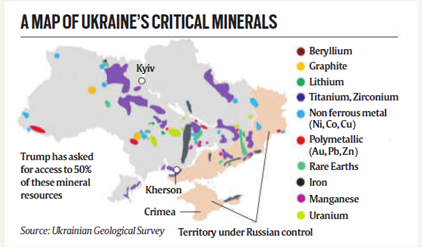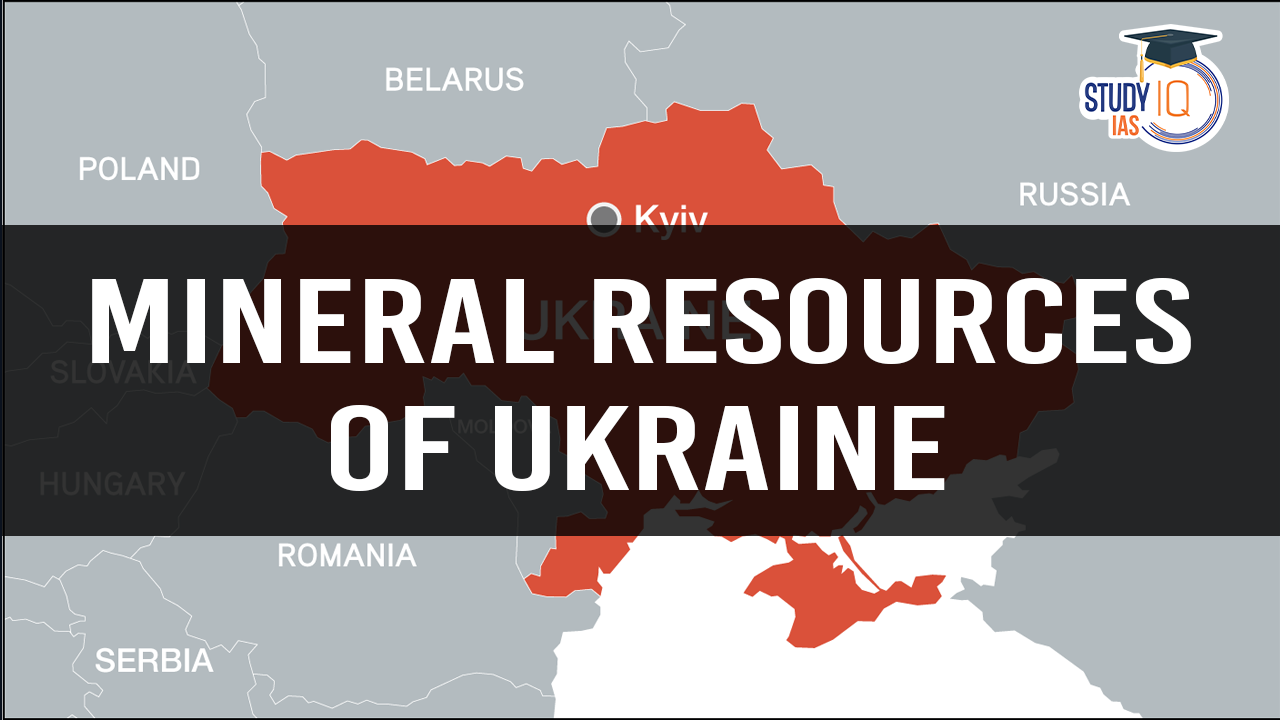Table of Contents
Context: The U.S. has proposed access to 50% of Ukraine’s critical minerals in exchange for military and economic assistance. Ukraine and the United States signed a deal that will give the United States preferential access to new Ukrainian minerals deals and fund investment in Ukraine’s reconstruction.
Importance of Mineral Resources in Ukraine
Ukraine has deposits of 22 out of 34 critical minerals identified by the European Union. Ukraine is rich in minerals that are essential for:
- High-tech manufacturing, including electronics and semiconductors.
- Defence systems, such as missile guidance and advanced weaponry.
- Clean energy solutions – electric vehicles (EVs).
- Strategic economic control, as China dominates the global supply of many of these minerals.
Ukraine’s Global Standing
- It has 22 out of 50 strategic minerals classified as critical by the U.S.
- 25 out of 34 minerals recognised as critical by the European Union (EU).

Types of Resources
- Industrial and construction materials
- Ferroalloy metals
- Precious and non-ferrous metals
- Some rare earth elements
Rare Earth Elements Found
- Lanthanum & Cerium – used in TVs and lighting
- Neodymium – used in wind turbines and EV batteries
- Erbium & Yttrium – used in lasers and nuclear power
- Scandium – identified in EU research, data classified
Key Strategic Minerals Identified by WEF
- Lithium
- Beryllium
- Manganese
- Gallium
- Zirconium
- Graphite
- Apatite
- Fluorite
- Nickel
- Lithium Reserves: Estimated at 500,000 metric tons
- Used in batteries, ceramics, and glass
- Found in central, eastern, and southeastern Ukraine
- Titanium: Mainly in northwestern and central Ukraine
- Graphite:
- Accounts for 20% of global resources
- Located in central and western Ukraine
- Used in EV batteries and nuclear reactors
- Coal: Significant reserves exist, but most are under Russian control
- Mining Status: Ukraine currently lacks operational rare earth mines
Major Challenges Facing the U.S. Plan
Legal and Constitutional Barriers
- Ukraine’s Constitution states that its natural resources belong to the Ukrainian people.
- Any foreign claim over these resources would require legal amendments.
Lack of Reliable Geological Data
- Ukraine’s mineral resources remain underexplored.
- The most comprehensive geological surveys were conducted before 1991 during the Soviet era.
Existing European Union Agreements
- In July 2021, before Russia’s invasion, Ukraine signed a “strategic partnership on raw materials” with the EU.
Russian Control Over Mineral-Rich Regions
- Many of Ukraine’s critical minerals are located in territories occupied by Russia.
- Russian forces have taken control of one-fifth of Ukraine, including key rare earth deposits.
Key Mineral Resources in Ukraine
1. Iron Ore
- Ukraine has the world’s sixth-largest iron ore reserves, primarily concentrated in the Kryvyi Rih Basin.
- These reserves are crucial for steel production and exports, particularly to Europe and Asia.
2. Coal
- Ukraine has extensive coal reserves, estimated at 34 billion tons, primarily located in the Donbas region.
- Coal is essential for Ukraine’s energy sector, though ongoing conflicts have disrupted production.
3. Manganese
- The Nikopol Basin holds one of the largest manganese ore deposits globally.
- Manganese is crucial for steelmaking and battery production.
4. Titanium
- Ukraine ranks among the world’s top titanium producers, with deposits in Zhytomyr and Dnipro regions.
- Titanium is used in aerospace, defence, and high-tech industries.
5. Uranium
- Ukraine is one of Europe’s largest uranium producers, essential for nuclear power generation.
- Major deposits are in the Dnipropetrovsk and Kirovohrad regions.
6. Lithium and Rare Earth Metals
- Ukraine has significant lithium reserves in Donetsk, Kirovohrad, and Zakarpattia regions.
- Lithium and rare earth metals are essential for electric vehicle (EV) batteries and renewable energy technologies.
Geopolitical and Economic Impact
- Ukraine’s mineral wealth makes it a strategic player in global resource markets.
- The ongoing conflict with Russia has affected mining operations and global supply chains for key resources.
- European nations and international companies are increasingly interested in Ukraine’s minerals, particularly lithium and titanium, for energy security and technological development.
What are Rare Earths and Their Uses?
- Definition: Rare earths are a group of 17 metallic elements essential for producing high-performance magnets.
- Applications: These magnets are critical in:
- Electric vehicles (EVs)
- Cell phones
- Missile guidance systems
- Other advanced electronics
- Substitutes: Currently, no viable substitutes exist for rare earths in these technologies.
- Classification: The U.S. Geological Survey (USGS) lists 50 minerals as “critical,” including rare earths, nickel, and lithium.
- Industrial Importance: Critical minerals are indispensable for sectors like:
- Defence
- Aerospace
- High-tech appliances
- Green energy technologies
| Facts |
| China remains the world’s largest producer of rare earths and several other critical minerals. |


 Iran Nuclear Crisis and India’s Role f...
Iran Nuclear Crisis and India’s Role f...
 H1B Visa Program, Beneficiaries, Eligibi...
H1B Visa Program, Beneficiaries, Eligibi...
 Comparison Between India & France's ...
Comparison Between India & France's ...

























